#India Sea ports
Explore tagged Tumblr posts
Text
Discover the importance of India's major ports that drive its international trade. Learn about key export and import hubs like Mumbai, JNPT, and Mundra, and how these ports are essential to India's growing economy and global commerce. Explore India's largest and busiest seaports today!
#major ports in India#ports in India#India sea ports#largest ports in India#major export ports in india#export ports in india#import ports in india#Mumbai port import and export#Visakhapatnam port import and export
0 notes
Text

Explore the major import and export ports in India and their vital role in the nation's economy. Learn about India's biggest export and import seaports, including Mumbai, Mundra, Visakhapatnam, and more. Discover key facts about India's maritime trade and how these ports contribute to international commerce.
#major ports in India#ports in India#India sea ports#largest ports in India#imports and exports of India
0 notes
Text
Discover Eximpedia's comprehensive list detailing the list 13 major ports and largest sea ports in India. Gain valuable insights into the country's maritime infrastructure, facilitating trade and commerce on a significant scale. Explore India's major ports with Eximpedia.
#Major Ports in India#Largest Ports in India#India’s major ports#India’s largest ports#List of Major Ports in India#India Sea ports#Largest Sea port in India
0 notes
Text
Bulk Dry Fish Exporters from India | Krishnaa exports
Krishnaa Exports is a leading bulk dry fish exporter from India, supplying premium-quality, naturally dried seafood worldwide. We ensure freshness, rich flavor, and long shelf life with strict quality control. Our competitively priced bulk exports meet international standards, making us a trusted choice for wholesalers and distributors. Choose Krishnaa Exports for high-quality dry fish supply with reliable global shipping.
#Sea port for dry fish#Dry fish export sear port#Dry fish supply port#Dry fish supply#Dry fish supplier india
0 notes
Text
Concerns Over India's "Hong Kong-Like" Development Project on Great Nicobar Islan

India’s ambitious development project on Great Nicobar Island, proposed to transform the remote region into a "Hong Kong-like" hub, has raised significant concerns among environmentalists and indigenous tribes. This $9 billion initiative, designed to include a transshipment harbor, power plant, airport, and township, aims to strengthen India’s position in global trade. Located near the crucial Strait of Malacca, the project is positioned to boost international commerce and tourism, potentially housing over 650,000 residents by its completion in 30 years. However, the development has sparked fears of ecological destruction and cultural loss for the island’s indigenous communities, especially the Shompen tribe, a nomadic group living in isolation.
Environmentalists warn that the project threatens to devastate the island’s fragile rainforests, home to rare species of flora and fauna, with over 900,000 trees potentially being cleared. The impact on local wildlife, including sea turtles and saltwater crocodiles, is also a major concern. Additionally, experts fear that the project could expose uncontacted tribes like the Shompen to diseases, jeopardizing their survival. Despite government assurances of environmental safeguards, many remain unconvinced, worrying that the development could irreparably alter the region’s delicate balance between nature and its indigenous cultures.
The development also evokes memories of the 2004 tsunami disaster, which displaced the Nicobarese tribe, and concerns that the project may push the island's tribes to the brink of extinction. As India moves forward with the plan, the tension between progress and preservation grows, with the future of both the environment and the island’s indigenous populations hanging in the balance.
#Great Nicobar Island#India#development project#Hong Kong-like port#environmental concerns#indigenous tribes#Shompen tribe#ecological impact#sea turtles
0 notes
Text
Top 11 major Shipping ports of the world
Click here to see in details...
#join merchant navy#join indian merchant navy#career in indian merchant navy#merchant navy guidance#Merchant navy Consultancy in india#merchant navy exam#top 11 ports of the world#worlds top shipping ports#sea ports of the world
0 notes
Text
Pearl of the Sea
Found Family! PoTC Cast x Teen! Non-binary! Reader Platonic! Will Turner x Reader Platonic! Elizabeth Swann x Reader Platonic! Jack Sparrow x Reader Platonic! Tia Dalma x Reader
Book:
Based on the Events of Curse of the Black Pearl, Dead Man's Chest, and At World's End
Prologue: Found at Sea
Chapter One: Troublemaking at the Promotion
Chapter Two: Battling in Port Royal
Chapter Three: Commandeering the Interceptor
Chapter Four: Recruiting on Tortuga
Chapter Five: Arriving at Isla de Muerta
Chapter Six: Outrunning the Black Pearl
Chapter Seven: Stranded on an Island
Chapter Eight: Dueling on Isle de Muerta
Chapter Nine: Hanging a Pirate
Chapter Ten: Arrested at a Wedding
Chapter Eleven: Captured by Cannibals
Chapter Twelve: Visiting the Witch
Chapter Thirteen: Hiring on Tortuga
Chapter Fourteen: Finding the Chest
Chapter Fifteen: Sword-Fighting for the Chest
Chapter Sixteen: Attacking Kraken
Chapter Seventeen: Sacrificing for Escape
Chapter Eighteen: Meeting Sao Feng
Chapter Nineteen: Journeying to the Locker
Chapter Twenty: Seeing the Dead
Chapter Twenty-One: Escaping the Locker
Chapter Twenty-Two: Bargaining for Freedom
Chapter Twenty-Three: Calling the Brethren Court
Chapter Twenty-Four: Parleying with Beckett
Chapter Twenty-Five: Freeing Calypso
Chapter Twenty-Six: Battling the East India Company
Chapter Twenty-Seven: Living a Free Life
Taglist:
@slytherinroyalty16
@aew-kun-age-regression
@grippleback-galaxy
@andsoigotabutterfly
@insomniacneedssleep
@painstakingly-juno
@kitkatlover015
@chronicallybubbly
@froggyisfriend
@elliottheidiot2007
@paastaboi
@urlocalsabito
@speckle-meow-meow
@dmitrytherat
@vanessa-boo
@ohimjustagirlidrathetnotbe
@snowy-violet
@ceridwyn3
@heil-nah
@idonthaveanameforthisacc
@roo024
@rory-cakes
#pearl of the sea#pearl of the sea masterlist#pirates of the caribbean x reader#pirates of the caribbean#potc x reader#potc#jack sparrow#jack sparrow x reader#x teen reader#x teen!reader#found family trope#found family#father figure#platonic#platonic x reader#platonic jack sparrow#jack sparrow x teen!reader#jack sparrow x teen reader#will turner x reader#will turner#platonic will turner#will turner x teen reader#will turner x teen!reader#elizabeth swann#elizabeth swann x reader#platonic elizabeth swann#elizabeth swann x teen!reader#potc x teen!reader#potc x teen reader#x gn reader
242 notes
·
View notes
Text

Today on the second advent and door no. 8 we have a lovely pair, La Grace and Shtandart

More about them here:
La Grace is a replica of a historic tall ship from the 18th century that will sail the seven seas like the original ship 300 years ago. The aim of the project is to give anyone interested the opportunity to sail a historic ship as part of the Navy's training programme and to share the proud traditions of sailing.
The brig was built between 2008 and 2010 by a group of volunteers from the Czech Republic and Slovakia in an Egyptian shipyard in Suez using traditional craft techniques. The brig was designed by its owners (Josef Dvorsky and Daniel Rosecky) according to technical drawings published in 1768 in the Architectura navalis mercatoria by the Swedish admiral Fredrik Henrik af Chapman.
According to available sources, the original La Grace was a ship owned by the first Czech naval captain Augustin Herrman, a famous navigator in Czech history. He sailed across the Atlantic in the service of the Dutch West India Company. After leaving the company, he commanded the small privateer ship La Grace. This relatively weak and vulnerable ship with six cannons brought large quantities of captured Spanish galleons to New Amsterdam every year.
The Shtandart is a replica of an 18th century frigate. The original was the first frigate built at the Olonez shipyard under Peter the Great and the first ship to be commissioned as a frigate for the Baltic Fleet. During the Great Northern War, Tsar Peter succeeded in conquering the area that would later become St Petersburg on the Neva. With the conquest of the fortress of Nöteborg in 1702, Lake Ladoga was removed from Swedish control and the Tsar hoped to gain access to Finland. The aim of these endeavours was to gain access to the Baltic Sea in order to establish a port city there for trade and naval purposes.
The frigate was built from 1702 at the Olonez shipyard on the Lodejner Feld on the River Swir near Lake Ladoga, where it was given its name in reference to the newly introduced Russian naval flag, a standard. Tsar Peter personally transferred the ship to the Baltic Sea in 1703. When seven Swedish ships of the line, five frigates and other small ships attacked the mouth of the Neva in June 1705, eight Russian frigates, presumably including the Schandart, lay behind a barrage of trees. In 1712 and 1713, she took part in troop landings in Swedish Finland near Vyborg. No further use is mentioned after this action. The ship was decommissioned as unserviceable in 1718. In 1723, the ship was scrapped in St. Petersburg.
According to another version, Tsar Peter had ordered the Schandart to be preserved as a reminder of the beginnings of the Russian fleet. Tsarina Catherine I ordered the condition of the Petrine ships to be examined in 1727. However, the Shtandart broke up while trying to take her out of the water.
As a result of the sanctions against Russia following the Russian invasion of Ukraine in 2022, Russian ships are denied access to European ports. However, following a request from the Président des Amis des Grands Voiliers association to the French Secretary of State, the Shtandart was granted permission to call at French and Spanish ports and has remained there ever since. There are plans to put her under the French flag, as her captain strongly distances themselves from Russia.
#naval history#tall ships#brig la grace#frigate shtandart#18th century#replicas#age of sail#advent calendar#day 8
108 notes
·
View notes
Text
Imagine losing your rudder out at sea and sending out a distress call. And then the largest ocean-going wooden sailing ship in the world comes to your rescue. [...] To our knowledge it is the first time that an east indiaman, and the first time for Götheborg, to engage in such a rescue.
Tuesday last week, the 25th of April [2023], Götheborg of Sweden was heading for the upcoming portstop in Jersey. Just after 4pm, a distress call was sent by the MRCC regarding a sailing vessel that had lost its rudder and was drifting. Being the closest ship to the sailing boat, Götheborg answered the call. The sailing boat was towed after the Götheborg during the night from the 25th to the 26th of April. In the morning the 26th of April, a French search and rescue boat from the port of Paimpol came and met up off the French coast.
Text from the sailors on the sailing vessel Corto:
On April 25th at 01:00, we left Cherbourg and set sail for Camaret (the tip of Brittany). We are two experienced sailors on board (Simon and me) with the objective of bringing the boat to Southern Brittany.
At 15:30, we were at sea, more than 50 nautical miles from the coast, when our rudder broke. After sending a PAN-PAN call on the VHF radio, the three-masted sailboat Götheborg quickly responded to our call, offering to tow us to Paimpol (France).
We repeatedly emphasized that we were aboard a small 8-meter sailboat, but the response was the same each time: "We are a 50-meter three-masted sailboat, and we offer our assistance in towing you to Paimpol." We were perplexed by the size difference between our two boats, as we feared being towed by a boat that was too large and at too fast a speed that could damage our boat.
The arrival of the Götheborg on the scene was rapid and surprising, as we did not expect to see a merchant ship from the East India Company of the XVIII century. This moment was very strange, and we wondered if we were dreaming. Where were we? What time period was it? The Götheborg approached very close to us to throw the line and pass a large rope. The mooring went well, and our destinies were linked for very long hours, during which we shared the same radio frequency to communicate with each other.
The crew of the Götheborg showed great professionalism and kindness towards us. They adapted their speed to the size of our boat and the weather conditions. We felt accompanied by very professional sailors. Every hour, the officer on duty of the Götheborg called us to ensure everything was going well.
The next day, as we approached the French coast, we radioed for another boat to help us enter the port, but no one responded positively. Around noon, the Götheborg approached us as closely as possible and stayed by our side until the arrival of a French rescue boat to ensure that everything would go well for us before letting us go.
This adventure, very real, was an incredible experience for us. We were extremely lucky to cross paths with the Götheborg by chance and especially to meet such a caring crew.
Dear commander and crew of the Götheborg, your kindness, and generosity have shown that your ship is much more than just a boat. It embodies the noblest values of the sea, and we are honored to have had the chance to cross your path and benefit from your help.
We thank you again for everything you have done for us.
Sincerely,
David Moeneclaey (skipper of the sailboat Corto)
908 notes
·
View notes
Text

Cartagena de Indias, Colombia: Cartagena known since the colonial era as Cartagena de Indias is a city and one of the major ports on the northern coast of Colombia in the Caribbean Coast Region, along the Caribbean sea. Cartagena's past role as a link in the route to the West Indies provides it with important historical value for world exploration and preservation of heritage from the great commercial maritime routes. Wikipedia
147 notes
·
View notes
Text

On October 31st, 1922, the crew of the steamer ship Bali witnessed something strange off the southern tip of India, west of Sri Lanka. Fourth officer P. Kruyt entered the sighting of a long necked sea serpent into the ship's logs. He also included this sketch of what he had seen. This was the first of many sea serpent sightings that were entered into the logs of Dutch Navy ships during this time.
Kruyt wrote:
"At about 4.30, about half a mile to port, the water began to be very disturbed until a little later there appeared in the same place an animal with a head and neck recalling a giraffe's but larger. The monster remained visible for about two minutes, and then dived back into the water head first. After which nothing was to be seen except that there were many birds above the place were the beast had disappeared. The serpent was about the same thickness everywhere, of circular section, the head ending in a blunt point. Its thickness was reckoned at about 18 inches, and the visible part about 15 feet long. It was grey-green in colour."
54 notes
·
View notes
Text
India's ports play a vital role in global trade, with 13 major seaports facilitating 95% of the country's trade by volume. Discover key ports like Mumbai, JNPT, and Mundra, and learn how these maritime hubs drive India's economic growth.
#major ports in India#ports in India#India sea ports#largest ports in India#imports and exports of India#major export ports in india
0 notes
Text
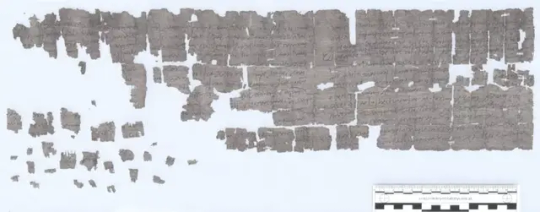
Archaeologists Find Roman Centurions' Letters in Ancient Animal Cemetery in Egypt
Discovered among the graves of hundreds of cats, dogs and monkeys, the correspondence was likely written by centurions in the first century.
An ancient pet cemetery in Egypt is becoming a gold mine for rare Roman history. Alongside its carefully constructed graves of more than 200 beloved cats, dogs and monkeys, archaeologists have now found letters handwritten 1,900 years ago by Roman centurions stationed nearby.
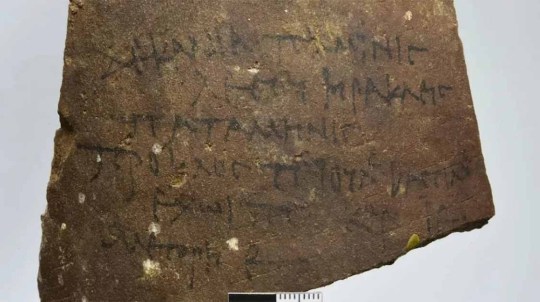
Though Rome controlled Egypt for centuries—from the year 30 to the mid-600s—few Roman sites still exist in the region, lead researcher Marta Osypińska, an archaeologist at Poland’s University of Wrocław’s Institute of Archaeology, tells Science in Poland’s Ewelina Krajczyńska. The burial ground, which dates back to the first and second centuries, is located in Berenike, a Red Sea port in southern Egypt built by Roman Emperor Tiberius.
Osypińska’s team first discovered the cemetery in 2011, and they’ve been slowly excavating it since then. Among the burials of cats, dogs and exotic monkeys, researchers have found ceramics, Roman coins and now, several letters written on papyrus by military officers who commanded units of Roman legions.
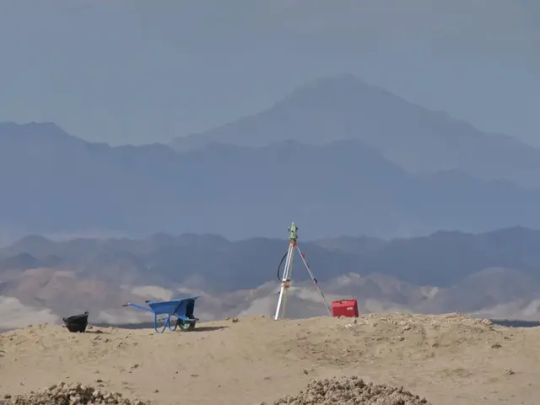
According to a statement by the University of Wrocław, these “priceless sources of knowledge about the ancient inhabitants of Berenike” are from the era of Emperor Nero, a cruel Roman ruler of the mid-first century. During his reign, Berenike was a hub of cross-continental trade, through which goods from India, Arabia and East Africa flowed, Osypińska says in the statement. The port was home to regional merchants, Roman higher-ups in charge of trading and—as historians have long suspected but never before proven—a unit of the Roman military.
The newly-found correspondence contains several names of presumed Roman centurions: Haosus, Lucinius and Petronius. In one letter, Petronius asks Lucinius, who is stationed in Berenike, about the prices of some exclusive goods, Osypińska tells Science in Poland. Petronius writes that he’s sending money via “dromedarius,” a unit of Roman soldiers traveling on camels, and tells Lucinius to provide the soldiers with veal and tentpoles.
Researchers believe ancient Romans likely kept the papyri in a nearby office which was later destroyed, accidentally distributing its contents over the pet cemetery, as McClatchy’s Aspen Pflughoeft writes. Excavators found the papyrus in rolled fragments, which they showed to Rodney Asta, an expert of ancient inscriptions, who pieced together a page approximately one and a half feet long and a foot wide, Osypińska tells Science in Poland. Among the animal graves, researchers have found countless ostracons—pieces of pottery etched with writing—but the papyri are the first paper texts to be found on-site.
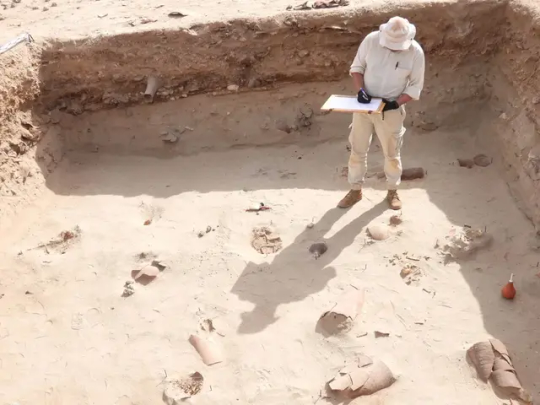
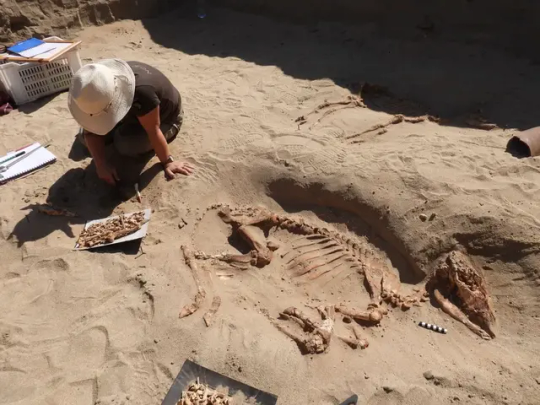
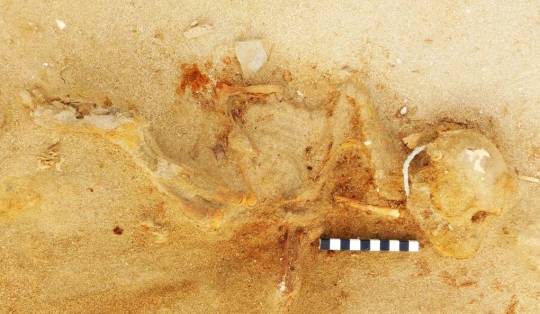
The letters are the latest evidence of advanced Roman trade to be found in the cemetery, per the statement: The skeletons of several buried monkeys, recently identified as macaques native to India, show that Romans imported non-utilitarian animals across oceans. These primates, along with long-haired cats and miniature dogs, were “elite pets,” and many were buried with toys, ceramics or other animal companions.
As Osypińska notes in the statement, it may seem difficult to reconcile the image of commanders of an ancient foreign legion with such animals, which were “treated as family members.”
“However, our findings unequivocally show that the military elite surrounded themselves with elite pets and led an exclusive lifestyle,” she adds.
By Sonja Anderson.

#Archaeologists Find Roman Centurions' Letters in Ancient Animal Cemetery in Egypt#Berenike#ancient pet cemetery in Egypt#Roman Emperor Tiberius#ancient artifacts#archeology#archeolgst#history#history news#ancient history#ancient culture#ancient civilizations#roman history#roman empire
74 notes
·
View notes
Photo

One of the major motivating factors in the European Age of Exploration was the search for direct access to the highly lucrative Eastern spice trade. In the 15th century, spices came to Europe via the Middle East land and sea routes, and spices were in huge demand both for food dishes and for use in medicines. The problem was how to access this market by sea. Accordingly, explorers like Christopher Columbus (1451-1506) and Vasco da Gama (c. 1469-1524) were sent to find a maritime route from Europe to Asia. To the west, Columbus found a new continent in his way, but to the south, da Gama did round the Cape of Good Hope, sail up the coast of East Africa, and cross the Indian Ocean to reach India. From 1500 onwards, first Portugal, and then other European powers, attempted to control the spice trade, the ports which marketed spices, and eventually the territories which grew them.
#HistoryFacts#History#VascoDaGama#PortugueseGoa#PortugueseEmpire#PortugueseCochin#Pepper#AgeOfExploration#Exploration#SpiceTrade#Trade#WHE
31 notes
·
View notes
Text
India’s Trusted Dry Fish Exporters | Krishnaa Exports
Krishnaa Exports is India’s trusted dry fish exporter, delivering premium-quality, naturally dried seafood worldwide. We ensure freshness, rich flavor, and long shelf life with strict quality standards. As a reliable dry fish supplier, we offer bulk exports at competitive prices. Choose Krishnaa Exports for sustainably sourced, high-quality dry fish, perfect for global markets.
#Dry fish supplier india#Dry fish supply#Dry fish supply port#Dry fish export sear port#Sea port for dry fish
0 notes
Text

HIS PORT IN THE STORM by lauryssamilkshakes
Summary:
“I suppose I have always been on solid land,” he said finally. “I have always been anchored, in a sense. Floating away in the middle of rough seas… it makes me uneasy, to say the least.” On the day they are set to depart to India for their first honeymoon, Anthony wakes early and contemplates in the library of Aubrey Hall. And this time, he confesses some of his worries to his wife.
Anthony had always been an early riser.
It did not seem to matter how late he had turned in the night before, or what he'd been doing, or where he'd been – he rose at dawn, or at the very least the otherwise early hours of the morning. He supposed it made sense, given his affinity to all that was outdoors, for the wonder of nature that he'd grown to further appreciate in the company of his then fiancée, now wife.
Now, he had woken to aching muscles and a sore jaw, but he grinned to himself nonetheless. He could withstand whatever the physical aftermath if it meant showing his wife exactly how much he loved her. Anthony sighed happily, recalling their forays into the grounds of Aubrey Hall for the first time as husband and wife yesterday, making love in all the places Kate wanted. On a blanket laid out on the grass. Against an ash tree. In the sunny depths of the lake. It had done absolutely everything for Anthony, hearing his wife say those words, seeing her grow bolder in voicing her desires, her wants, her needs. By the end of the day, Kate gave her husband orders and he not only readily listened but delighted in doing so. He relished it, revelled in it, in giving into the power his wife had over him simply by telling him what she wanted. Anthony knew that Kate did not consider such things nearly as often as she should, as she deserved, as she had every right to.
Absentmindedly, Anthony shifted slightly, watching his wife's sleeping form. She seemed content as she slept, a smile playing at her lips even in slumber, her arm slung around his bare waist, and Anthony could not help but drop the faintest kiss on her temple. They had tired themselves out yesterday, and it would not do for him to wake her when she was sleeping so soundly.
Read on AO3
#bridgertonedit#dailybridgerton#perioddramaedit#perioddramasource#weloveperioddrama#perioddramacentral#filmtvcentral#dailytvfilmgifs#dailyflicks#otpsource#televisiongifs#dailynetflix#romancegifs#smallcreensource#wonderfulwoc#femaledaily#dailywomen#myedit#my fic
22 notes
·
View notes